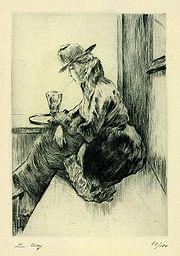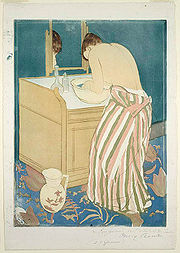
Drypoint
Encyclopedia

Printmaking
Printmaking is the process of making artworks by printing, normally on paper. Printmaking normally covers only the process of creating prints with an element of originality, rather than just being a photographic reproduction of a painting. Except in the case of monotyping, the process is capable...
technique of the intaglio
Intaglio (printmaking)
Intaglio is a family of printmaking techniques in which the image is incised into a surface, known as the matrix or plate, and the incised line or area holds the ink. Normally, copper or zinc plates are used as a surface, and the incisions are created by etching, engraving, drypoint, aquatint or...
family, in which an image is incised into a plate (or "matrix") with a hard-pointed "needle" of sharp metal or diamond point. Traditionally the plate was copper
Copper
Copper is a chemical element with the symbol Cu and atomic number 29. It is a ductile metal with very high thermal and electrical conductivity. Pure copper is soft and malleable; an exposed surface has a reddish-orange tarnish...
, but now acetate
Cellulose acetate
Cellulose acetate , first prepared in 1865, is the acetate ester of cellulose. Cellulose acetate is used as a film base in photography, as a component in some adhesives, and as a frame material for eyeglasses; it is also used as a synthetic fiber and in the manufacture of cigarette filters and...
, zinc
Zinc
Zinc , or spelter , is a metallic chemical element; it has the symbol Zn and atomic number 30. It is the first element in group 12 of the periodic table. Zinc is, in some respects, chemically similar to magnesium, because its ion is of similar size and its only common oxidation state is +2...
, or plexiglas are also commonly used. Like etching
Etching
Etching is the process of using strong acid or mordant to cut into the unprotected parts of a metal surface to create a design in intaglio in the metal...
, drypoint is easier for an artist trained in drawing to master than engraving
Engraving
Engraving is the practice of incising a design on to a hard, usually flat surface, by cutting grooves into it. The result may be a decorated object in itself, as when silver, gold, steel, or glass are engraved, or may provide an intaglio printing plate, of copper or another metal, for printing...
, as the technique of using the needle is closer to using a pencil than the engraver's burin.
Lines and burrs
The lines produced by printing a drypoint are formed by the burr thrown up at the edge of the incised lines, in addition to the depressions formed in the surface of the plate. A larger burr, formed by a steep angle of the tool, will hold a lot of ink, producing a characteristically soft, dense line that differentiates drypoint from other intaglio methods such as etchingEtching
Etching is the process of using strong acid or mordant to cut into the unprotected parts of a metal surface to create a design in intaglio in the metal...
or engraving
Engraving
Engraving is the practice of incising a design on to a hard, usually flat surface, by cutting grooves into it. The result may be a decorated object in itself, as when silver, gold, steel, or glass are engraved, or may provide an intaglio printing plate, of copper or another metal, for printing...
which produce a smooth, hard-edged line. The size or characteristics of the burr usually depend not on how much pressure is applied, but on the angle of the needle. A perpendicular angle will leave little to no burr, while the smaller the angle gets to either side, the larger the burr pileup. The deepest drypoint lines leave enough burr on either side of them that they prevent the paper from pushing down into the center of the stroke, creating a feathery black line with a fine, white center. A lighter line may have no burr at all, creating a very fine line in the final print by holding very little ink. This technique is different from engraving
Engraving
Engraving is the practice of incising a design on to a hard, usually flat surface, by cutting grooves into it. The result may be a decorated object in itself, as when silver, gold, steel, or glass are engraved, or may provide an intaglio printing plate, of copper or another metal, for printing...
, in which the incisions are made by removing metal to form depressions in the plate surface which hold ink, although the two methods can easily be combined, as Rembrandt often did. Because the pressure of printing quickly destroys the burr, drypoint is useful only for comparatively small editions; as few as ten or twenty impressions with burr can be made, and after the burr has gone, the comparatively shallow lines will wear out relatively quickly. Most impressions of Rembrandt prints on which drypoint was used show no burr, and often the drypoint lines are very weak, leaving the etched portions still strong. To counter this and allow for longer print runs, electroplating
Electroplating
Electroplating is a plating process in which metal ions in a solution are moved by an electric field to coat an electrode. The process uses electrical current to reduce cations of a desired material from a solution and coat a conductive object with a thin layer of the material, such as a metal...
(called steelfacing by printmakers) can harden the surface of a plate and allow the same edition size as produced by etchings and engravings.
History

Old master print
An old master print is a work of art produced by a printing process within the Western tradition . A date of about 1830 is usually taken as marking the end of the period whose prints are covered by this term. The main techniques concerned are woodcut, engraving and etching, although there are...
Albrecht Dürer
Albrecht Dürer
Albrecht Dürer was a German painter, printmaker, engraver, mathematician, and theorist from Nuremberg. His prints established his reputation across Europe when he was still in his twenties, and he has been conventionally regarded as the greatest artist of the Northern Renaissance ever since...
produced 3 drypoints before abandoning the technique; Rembrandt used it frequently, but usually in conjunction with etching
Etching
Etching is the process of using strong acid or mordant to cut into the unprotected parts of a metal surface to create a design in intaglio in the metal...
and engraving
Engraving
Engraving is the practice of incising a design on to a hard, usually flat surface, by cutting grooves into it. The result may be a decorated object in itself, as when silver, gold, steel, or glass are engraved, or may provide an intaglio printing plate, of copper or another metal, for printing...
. As intaglio
Intaglio (printmaking)
Intaglio is a family of printmaking techniques in which the image is incised into a surface, known as the matrix or plate, and the incised line or area holds the ink. Normally, copper or zinc plates are used as a surface, and the incisions are created by etching, engraving, drypoint, aquatint or...
techniques, they can all be used on the same plate. Alex Katz
Alex Katz
Alex Katz is an American figurative artist associated with the Pop art movement. In particular, he is known for his paintings, sculptures, and prints and is represented by numerous galleries internationally.-Life and work:...
used this process to create several of his famous works, such as "Sunny" and "The Swimmer".
In the 20th Century, many artists produced drypoints, including Max Beckmann
Max Beckmann
Max Beckmann was a German painter, draftsman, printmaker, sculptor, and writer. Although he is classified as an Expressionist artist, he rejected both the term and the movement...
, Milton Avery
Milton Avery
Milton Avery was an American modern painter. Born in Altmar, New York, he moved to Connecticut in 1898 and later to New York City.-Biography:...
, and Hermann-Paul
Hermann-Paul
René Georges Hermann-Paul was a French artist. He was born in Paris and died in Saintes-Maries-de-la-Mer.Recent efforts to catalog the work of Hermann-Paul reveal an artist of considerable scope. He was a well-known illustrator whose work appeared in numerous newspapers and periodicals...
. By adding aquatint
Aquatint
Aquatint is an intaglio printmaking technique, a variant of etching.Intaglio printmaking makes marks on the matrix that are capable of holding ink. The inked plate is passed through a printing press together with a sheet of paper, resulting in a transfer of the ink to the paper...
work on the plate and inking with various colours, artists such as Mary Cassatt
Mary Cassatt
Mary Stevenson Cassatt was an American painter and printmaker. She lived much of her adult life in France, where she first befriended Edgar Degas and later exhibited among the Impressionists...
have produced colour drypoints. Canadian artist David Brown Milne
David Brown Milne
David Brown Milne was a painter, printmaker, illustrator, watercolourist and writer, credited to have been the first to produce coloured drypoints by the use of multiple plates, one for each colour.- Biography :Born and brought up as the youngest of 10 children to a family of Presbyterian...
is credited as the first to produce coloured drypoints by the use of multiple plates, one for each colour.
Types of needles
Any sharp object can theoretically be used to make a drypoint, as long as it can be used to carve lines into metal. Dentistry tools, nails, and metal files can all be used to produce drypoints. However, certain types of needles created specifically for drypoints are preferred:- Diamond-tipped needles carve easily through any metal and never need sharpening, but they are expensive.
- Carbide-tipped steel needles also can be used to great effect, and are cheaper than diamond-tipped, but they frequently need sharpening to maintain a sharp point. Steel needles were traditionally used.

